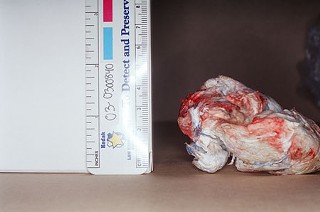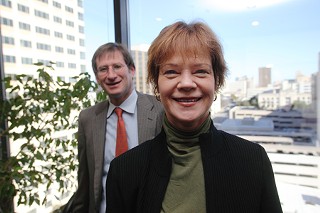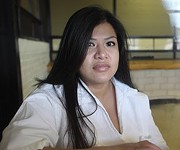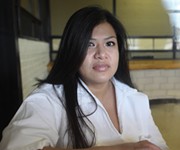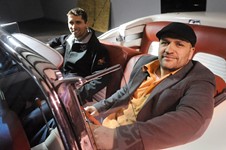A Parliament of Experts
Did 'expert testimony' convict an innocent woman of murder?
By Jordan Smith, Fri., Feb. 4, 2011
Jan. 30, 2003, was supposed to be a day off for Victoria Gutierrez. Instead, the then-19-year-old Mexican immigrant was called in unexpectedly to the Northwest Austin restaurant where she'd been working for almost five years, she testified in 2005.
So she took her 21-month-old son, Bryan, to the North Austin apartment of Rosa Jimenez, an undocumented immigrant from Ecatepec de Morelos (a town near Mexico City), who was six months pregnant at the time and had a 1-year-old daughter. Jimenez had been babysitting for Bryan two or three times per week for nearly seven months, and she loved the little boy as her own, she told police later.
When Gutierrez brought Bryan over around 9am, Jimenez readily welcomed him into the small apartment she shared with her husband, Fidel, who was at work. She took him to the bedroom and put him down for a nap; he slept next to Jimenez's daughter, Brenda. The children both awoke some time before 11am, Jimenez would later tell Austin Police Department then-Detective Eric de los Santos. She gave them a small bag of dry cereal to share, and the two children sat on the bed watching TV while Jimenez continued her chores. Bryan and Brenda both had colds that day, she said, and she helped Bryan blow his nose several times.
Jimenez was folding clean clothes when Bryan came to her to let her know he was hungry. Jimenez went to the kitchen, around a slight corner from the living area, to prepare pico de gallo with some beans for herself and eggs with cheese for the kids. At some point, she stopped to grab a roll of paper towels. Bryan again needed his nose wiped, so she washed her hands and, with them still damp, pulled off a sheet of paper towel. She tossed the roll onto the couch and bent to wipe the toddler's nose. "After that, I took the paper and I threw it in the garbage can," Jimenez told de los Santos during a more than five-hour interview with the detective, conducted in Spanish (at the time, Jimenez did not speak English). "I did not move the roll from there."
A few minutes later, Bryan and Brenda came to her with shreds of paper towel they'd apparently pulled from somewhere – perhaps from the roll she'd left on the couch. She told them not to do that and asked Bryan to show her what he was up to. "And he didn't want to, and he left running to the room with [Brenda]," Jimenez said. They went back toward the toys, so she returned her attention to the stove. She continued to cook, peering occasionally around the kitchen's half-wall to check on the children. She could see Bryan with his back to her, standing in the bedroom – just a short distance from her vantage point – either playing with toys or watching the TV.
At most, she would tell de los Santos later, there was a 10-minute gap when she was focused on the kitchen and not the children. "When all of a sudden I saw that Bryan ... was coming ... slowly, walking ... with his little hand here on [his] throat," she said. She recognized that he was choking, but she did not know on what.
What happened next is disputed. Jimenez said she grabbed Bryan and ran toward the bathroom; she hit him on the back and performed the Heimlich maneuver – two techniques she'd learned previously from a doctor after Brenda had choked on a corn chip. Bryan was still choking, turning purple and with a "trickle of blood" at the corner of his mouth. She tried to pry open his jaw to see what he had in his mouth; he struggled against her efforts and bit her thumb, and she couldn't see anything. Jimenez didn't have a phone in her apartment, and now panicked, embracing the boy to her chest, she ran for the front door and, screaming hysterically (as a neighbor would later describe it), ran to the nearby apartment of Irene Vera, who Jimenez knew had a phone.
Vera laid Bryan on the floor; she too tried to feel inside his mouth, but he bit her. At 1:28pm, a second neighbor, Paula Salinas, who'd heard Jimenez screaming and had followed her to Vera's apartment, called 911. Three minutes later, Officer William Torres arrived at the apartment where he found Vera on the phone, kneeling next to Bryan's body. "He had a little bit of blood on his cheek, but there was no movement at all," he testified in court. "His eyes were wide open. They wouldn't even move. His lips were blue and starting to get puffy. His mouth was open but not all the way. It was open just a little bit. Because I remember when ... I tried to put my finger in there, it would only go about halfway." After checking for a pulse and finding none, Torres began CPR – it was the first time in his 12 years with APD that he'd had to use the resuscitation skills he'd learned at the academy.
It wasn't working. Bryan's cheeks were "puffing out," but his chest was not rising. Roughly two minutes later, EMS arrived; the two paramedics also tried to resuscitate Bryan, using chest compressions and a bag mask, but that didn't work either – when they'd pull the bag mask off, Bryan's cheeks and lips would bulge. The paramedics administered epinephrine and inserted a laryngoscope into Bryan's airway: "I saw a [reddish] mass to the back of the airway which initially I could not identify," then-paramedic Robert Curr testified. It took three tries with a set of forceps to remove the obstruction; when they were finally able to pull it out, past Bryan's teeth – a process with so much force and maneuvering involved that it pulled the child's head up off the floor – the object "made a very sickly sucking sound," he recalled. The object, he said, was tightly compacted and wet.
The object that choked Bryan was an intact spread of five white paper towels, with inked red and blue butterflies decorating the edges – towels that matched the roll Rosa Jimenez said she'd tossed on her couch after blowing the little boy's nose.
Bryan was rushed to the hospital and put on a ventilator. Jimenez, who could not find a phone number for Victoria Gutierrez, was taken to the police station and interviewed for hours about what had happened. When Gutierrez went to the apartment late that afternoon to pick up her son, she was greeted by police – and a crime scene. The officer told her only that there had been an accident; one took her to the hospital where a doctor said that Bryan "was in serious condition," she testified, crying, in the summer of 2005. "That he wasn't the baby that I – that I knew." The paper towel obstruction had deprived Bryan of oxygen long enough to sustain serious brain injury; three months later – after weeks in hospice care and just two weeks after his 2nd birthday – Bryan died.
The State's Experts Concur
Two-and-a-half years later, in August 2005, Jimenez was charged and tried for murder and serious bodily injury to a child.
According to prosecutors, the cause of Bryan's death was clear. Rosa Jimenez had – for reasons unknown – taken five attached sheets of paper towel, wadded them up tightly, and jammed them down Bryan's throat, depriving him of air. She then waited – while he choked and turned blue and began to die – before taking him to Vera's apartment and calling 911, giving herself a chance to clean up the traces of her crime. She washed blood from the side of her bathtub, and possibly even removed and hid the sheets from her bed. Yet police did not find bloody bed sheets in the apartment, and although there was a drop of Bryan's blood on the tub, there was no evidence to suggest that there had been more blood there, nor were there any signs that someone had tried to clean additional blood stains.
Jimenez has maintained her innocence. She would never hurt Bryan, she told police; she loved him. She repeatedly told de los Santos during the hours of questioning that she had no idea what had happened or how Bryan had gotten the paper towels into his throat. Jimenez was aware that small toys could be a choking hazard, she told the detective, which is why she'd taken all the small toys from the living room and placed them in a box that she stored where the kids couldn't reach them. But she never thought about paper towels, she said – including the roll that she'd tossed onto the couch that day. "I mean ... I never thought he was ... going to choke with the paper," she said, according to the translated transcript of the interview.
Her protestations that she had nothing to do with Bryan's choking and that she could not explain how it had happened – in essence, that it was a tragic accident – impressed neither law enforcement officials nor the doctors who treated Bryan at the hospital. When asked in court for their opinions about whether this could have been an accident, each of the doctors the state called to the witness stand – an emergency room doctor, a pediatric intensive-care doctor, a medical examiner, and a child abuse specialist – testified that there was no way it could have been an accident.
In fact, nearly every witness who testified against Jimenez at her trial testified, in varying degrees, as an "expert" – not only did the doctors have an opinion for the jury about key elements of the case, but so did police and even the 911 dispatcher who took the initial call for help.
But who, exactly, is in the best position to say what happened to Bryan Gutierrez that day – beyond a reasonable doubt? The only adult present in the apartment, Jimenez, insists that Bryan's choking was an accident. Although Jimenez did not testify at trial, the video of her interview with police was played for the jurors, who could follow along with a printed transcript. In the end, it seems the jurors believed the experts; after a six-day trial the jury found Jimenez guilty, sentencing her to 99 years in prison.
Did the experts in this case – the doctors who forcefully asserted that this had been no accident – help put a cold-blooded child-killer behind bars? Or did the state's use of expert witnesses to explain the fatal injury convince a jury to convict an innocent person? More broadly, in such an expert-dependent case as this – one that demands professional certainty on difficult questions – what is the effect of expert witnesses? Who is the best expert? Who decides? What if they're wrong? And what impact does the use of expert witnesses have on our criminal justice system?
Five years after her trial, after hearings over several days in December 2010, then-Travis County District Judge Charlie Baird concluded that Jimenez is entitled to a new trial. Her new defense attorneys proffered additional expert testimony to counter the expert evidence offered by the state at trial, testimony that Baird found credible. Had Jimenez's jury heard any alternate theory of the crime, it is unlikely that the verdict would have been the same, Baird opined, concluding that Jimenez had been denied due process and that her attorney, veteran defender Leonard Martinez, had rendered ineffective assistance to his client. If the Court of Criminal Appeals agrees, Jimenez's case may be coming back for a retrial.
Should that happen, the case will put the use of experts under a criminal justice spotlight.
Experts Assembled
To attorney Bryce Benjet, who along with Susan Henricks is now representing Jimenez, the case against his client is all about medical expertise – and its limits. He firmly believes in his client's innocence and that the experts who opined that the paper towel choking could not be an accident are the only reason Jimenez is behind bars. "This was not a witnessed event; no one saw Bryan Gutierrez choke," he said in a recent interview. The case was "almost entirely about the opinions of doctors who treated Bryan ... after the obstruction was removed. Without their testimony, there would be no evidence to show any guilt at all," he said. "That is why the reliability of the experts at trial was crucial."
Each of the state's medical witnesses came to court with the expected credentials, and each agreed that they'd never before seen a case like Bryan's. That, in part, seemed to convince them that his choking could not be an accident. The doctors agreed that children, including those Bryan's age, put all kinds of things in their mouths – buttons and marbles and coins and rocks, for example – and will, at times, choke on those items, particularly smooth things, like hot dogs, which are among the biggest offenders in child choking cases. But none believed that a child would put paper towels, and certainly not that many, in his mouth: "children don't suck on paper towels," Dr. Patricia Aldridge (then Patricia Oehring) declared during her testimony. Furthermore, even if a child were to put something in his mouth like a "woody"-tasting paper towel, Aldridge reiterated during her most recent testimony in December – and something as large as five wadded paper towels – the child wouldn't then try to swallow it.
Aldridge also posited that even if Bryan had gotten that large a wad in his mouth and started to choke on it, once the mass hit his soft palate he would have continued to gag and cough until he expelled the paper: "There's no such thing as bypassing a reflex," she said. Dr. John Boulet, who treated Bryan in the emergency room, agreed: "I don't know of any reason that a previously healthy 21-month-old baby would be putting a paper towel down his own throat far enough to block his airway," he said. Dr. Elizabeth Peacock, then the county's deputy medical examiner, said that Bryan "would not be able to" put the paper down his own throat. Peacock did not perform Bryan's autopsy, but she testified for the jury about then-retired Dr. Vladimir Parungao's findings along with her own conclusions. "The mouth of a 21-month-old can hold a lot of food. However, right at the back of the mouth, it narrows abruptly to a rather small opening," she said. "The only [thing] that can really get down there and obstruct, in my opinion ... [is] something that's round or small to that degree," such as a grape.
In short, Aldridge testified – ostensibly summing up for all three doctors – there was no way that Bryan did this to himself. "He would have had to have been held down," she began. "If you've ever tried to keep almost a 2-year-old in one place, he'd have had to have been held down, I would imagine, probably on the floor with some part of somebody's body holding him in that one position," she continued. "Once ... somebody's hand and a paper towel was in his mouth, that would ... probably hold his head still enough. But he would have been coughing and gagging and bleeding and fighting and struggling to the point where his brain didn't get enough oxygen to where he became limp."
According to Aldridge, there is also no way that Jimenez acted immediately to find medical assistance. She knows this, she testified, because Bryan's blood gas level, which detects the amount of oxygen and carbon dioxide in the blood as a measure of lung function, was too deficient for him to have been without oxygen only for a little more than 10 minutes. Instead, she said, he was likely without air for up to 40 minutes – an assessment that seems to have informed the prosecutors' theory that Jimenez allowed the boy to choke and gasp for air while she went around cleaning up the crime scene (all the while apparently deciding not to hide or put away the paper towel roll police found on the couch – or to turn off the stove, which was still on when police later entered Jimenez's apartment).
In short, based on the state's medical testimony, there was no doubt that Bryan's death was a homicide perpetrated by Rosa Jimenez, the only adult in the apartment that day.
SNAFU Defense
That theory stood, essentially without contest, because Jimenez's defense had no resources to hire its own experts. Jimenez's appointed lead attorney, Martinez, said he asked then-Judge Jon Wisser, who presided over the 2005 trial, for funds to counter the state's contingent of doctors, but his request was denied. Martinez had only enough resources to hire a single expert, one who did not have any specific experience in choking or in pediatrics. Doctors who Martinez approached with distinct expertise in these areas were unwilling to put the time and effort into the case without any promise that they would be compensated appropriately. (One doctor, well-known Dallas-based pathologist Linda Norton, declined to help because she had been stiffed by Travis County after her testimony in a previous case).
In the end, Martinez secured the help of a Connecticut state medical examiner, Dr. Ira Kanfer. Kanfer failed to bring his résumé to court – often expected of experts, as a way to boost their credibility with jurors (Martinez apparently didn't have a copy). Kanfer indeed testified that he believed Bryan could have taken a wet wad of paper towels and slowly sucked it back into his throat, ultimately choking himself.
But the doctor suffered a near-meltdown under cross-examination by Assistant District Attorney Allison Wetzel, a tough prosecutor with a quick and biting style. After making it through her questioning, Kanfer made off-the-stand comments about Wetzel and her co-counsel, Assistant D.A. Gary Cobb, including that the prosecutors could "go fuck [them]selves." When Kanfer again took the witness stand, Wetzel questioned him about his statements, which he readily admitted making. "That's an exactly correct quote," he told Wetzel.
Although Martinez tried to rehab Kanfer in later questioning, the damage had been done. Indeed, in ruling that Jimenez should receive a new trial, Baird noted that having Kanfer testify was probably worse than having no expert at all: "To the extent Dr. Kanfer's testimony had any persuasive value (which is highly doubtful), the Court finds that it was completely and 100% undermined by [his] unprofessional conduct at trial," Baird wrote.
Equally damaging, Benjet says, was the failure of Martinez to object to any of the medical opinions offered as evidence by the state's witnesses, particularly the assertions of Aldridge. "That wasn't done here," says Benjet. "And I think a perfect example of the speculation that you see throughout [the trial is] Aldridge hypothesizing about how" Bryan would have been restrained to accomplish the choking – a physical encounter that she also said she would not necessarily expect would leave any physical trace on Bryan or on Jimenez. (Indeed, Bryan was examined for other injuries, but the doctors found nothing to indicate any physical abuse.) This was clearly outside what she could medically know and is a perfect example of a witness "testifying beyond the scope of their expertise," he said. And that's exactly what Benjet and Henricks sought to demonstrate during the December writ hearing before Baird.
Unsolid Science
After Mexican documentarians made an award-winning film about Jimenez's case (a sympathetic portrait of the plight of an undocumented immigrant caught up in the Texas justice system), the state of Mexico got involved and, via the municipality that Jimenez is from, is now paying for her legal representation. That means that Benjet and Henricks are far better funded than was Martinez, allowing the lawyers to find experts that Benjet says are leading in the field of pediatric airways and choking. Two of the three experts they hired – Dr. Karen Zur, a pediatric otolaryngologist who specializes in removing objects from children's airways, and Dr. John McCloskey, a pediatric anesthesiologist and critical care specialist – testified before Baird in December that after reviewing the entire case file, they are of the opinion that the choking could indeed have been a tragic accident. Each told the court that in their professional careers they were aware of unintentional choking cases involving very large items. In fact, McCloskey testified, he was aware of two separate instances in which young children had somehow choked on large rubber "super balls."
Moreover, the two experts countered key assertions offered as facts by Aldridge and by Peacock at trial, including that the gag reflex would have forced the paper towels up and out of Bryan's throat. Zur, who is an expert in the anatomy of the airway, told Baird that the gag reflex actually works two ways – to push items out and to pull items in. If the paper towels were partially obstructing the airway, allowing air to intermittently get into Bryan's lungs, the gag reflex could also have been working to continue that obstructing influence as the muscles pulled the wad tighter into his throat, trying to swallow it.
And, importantly, McCloskey said that there is absolutely no support in the medical literature for Aldridge's assertion that a blood-gas reading can offer insight into how long a person has been without air. To determine if a reading were meaningful in that context, a doctor would need much additional information – including, for example, data about the patient's metabolism – information that wasn't available to the doctors treating Bryan. At best, McCloskey said, Aldridge would be able to say that, based on the extent of brain damage caused by hypoxia, Bryan had been without oxygen for roughly 10 minutes – but that, too, would be dependent on multiple factors.
These are key differences in opinion that should have been heard by a jury, Benjet says. Martinez agrees that he needed exactly this kind of support back in 2005. "We needed more resources; we needed more experts," he said. "We were hamstrung; our hands were tied, and we didn't get what we needed." Both attorneys agree that the case against Jimenez simply came down to which witnesses were most influential with the jurors. "The expert has a unique role," Benjet said. "They are recognized by the court as having superior knowledge. So when a person in that position points their finger and says a person is guilty, we'd better be sure they're pointing at the right person" and making statements based on solid science.
Expertise or Performance?
Experts do have a unique and influential role with juries. On that point legal experts – experts on the use of experts, that is – agree. And the use of experts in criminal cases is fraught with problems, says University of Michigan Law School professor Samuel Gross, who in 1991 wrote for the Wisconsin Law Review a still widely cited paper on expert evidence. In the 20 years since he wrote the paper, which is critical of the use of experts and their impact on the adversarial process, not much has changed, he said during a recent interview. "The only thing that's changed is, I think, there are more courts and other bodies aware of the fact that expert evidence in criminal cases, in particular, is in a troubling state."
According to professor D. Michael Risinger, who teaches at Seton Hall University School of Law and has been "observing" the use of experts since the late 1970s, understanding of the use and influence of experts has certainly increased over the last four decades, but that doesn't mean experts are necessarily better used – or that unreliable testimony is being kept out of court. "What you're seeing are more fights [over evidence] ... but that doesn't mean you're seeing more things excluded," he said. In brief, Risinger notes that in civil cases, lawyers and judges are much more stringent about the use of experts and about the subjects on which specific experts may testify – civil defendants "most of the time" are able to keep out plaintiffs' proffers of expert testimony, he wrote in a 2000 law review article. In the criminal context, however – with life or liberty at issue – the opposite appears to be true, and criminal defendants usually lose in their efforts to exclude expert testimony proffered by the state. In general, Risinger says, "criminal defense attorneys have done a miserable job" at keeping questionably reliable expert testimony out of evidence– in part, he says, because criminal defenders are often overworked and saddled with too much to do and too few resources with which to do it.
That reflects Benjet's experience. Benjet started out in criminal law – he used to work for the Texas Defender Service and still does appellate criminal work – but the bulk of his practice now is on the civil side, often defending medical malpractice cases. The scrutiny of experts in that context is strikingly different from that in the criminal courts, he said. "For experts in the medical malpractice context, we've seen changes in the law, support by the Attorney General's Office and all the way up, [imposing] very strong restrictions on who can testify about injuries and consequences [of those injuries]. In the civil context, not any doctor can testify about any injury," he said. "Unfortunately, we as a society have decided not to require that kind of reliability in these criminal [cases]. But the Constitution requires that kind of reliability," he continued. In short, he says, it's "time for the criminal justice system to catch up."
And the failure to keep out, or even to challenge, state proffers of expert testimony means that juries (and judges) run the risk of making decisions about individual liberty based on unreliable opinions. Risinger says there's no doubt that jurors are influenced by expert witnesses: "These people come into court blessed by the judge. They look authoritative, speak authoritatively, and they have paper credentials." But that doesn't necessarily mean that they know what they're talking about. A related problem, of course, is that the system is generally underfunded, says Gross, and without a healthy balance between state and defense, the entire adversarial system can be undermined. In this system, the state usually has access to numerous experts, including many, like medical examiners, who are institutional players. With "limited funds, or none, and no access to experts" to counter the state power, the adversarial process fails. "So whatever adversarial system [there is], if there is only one side to it, it falls apart entirely."
Gross says he can't say specifically that medical experts are unduly influential on jurors, but he suspects they do wield power. "What I can say is that a good expert – that is, an expert who is an effective witness – can be very influential," he said. "When we're in the situation where you're looking for a physician to give advice and get treatment, if you find someone who strikes you as caring and intelligent and reasonable, you breathe a sigh of relief," he posits. "If you have a doctor who creates that impression for a jury – answers questions you'd like a doctor to be able to answer – [and] he's the kind of person you say, 'I'm glad he's treating me,' how could a jury not be influenced by this in the context" of being a witness in a criminal trial? The problem, he says, is that, at times, "some people [who] create that kind of impression are better performers than doctors or scientists."
The best example of that kind of expertise is that of deceased forensic psychiatrist Dr. James Grigson, known as "Dr. Death" for his hundreds of appearances as an expert witness for the state in death penalty cases. Grigson was reprimanded multiple times by professional organizations for allegedly unethical practices, in part for testifying about the future dangerousness of defendants, some of whom he'd never even examined. After he was expelled in 1995 from the American Psychiatric Association and the Texas Society of Psychiatric Physicians for alleged ethical violations, Grigson told The Dallas Morning News that he didn't expect the censures would affect his testifying as an expert for the state. "For them to say I'm unethical ... it's really an insult," he told the daily. Gross says Grigson was exactly the kind of expert that put on a good show for jurors. "He was very manipulative; he wanted to persuade people. You think of him as 'Dr. Death,' but he didn't come across as bloodthirsty" when testifying, he said. "But the problem is that he was testifying to things he had no way of knowing."
Courts, lawyers, lawmakers, and legal experts have increasingly realized that there are problems with expert testimony, particularly in the forensic sciences, an issue that came to the fore with the 2009 publication of the National Academy of Sciences report on forensic science. The report, commissioned by Congress, revealed that while forensics can provide valuable evidence and testimony – not only to convict but to clear the wrongfully convicted – many of these sciences (most conceived for the purpose of providing evidence in criminal settings) are not built on a solid scientific foundation, which can lead to grave errors in methodology and analyses. The report contains a number of recommendations – including that forensic labs should be removed from police agencies, where they're subject to potential prosecutorial biases. Even the Texas Court of Criminal Appeals – no friend of defendants – has recently ruled in ways that might curtail certain "expert" analysis in court. Last year, the court overturned the conviction of a man based on scent-lineup evidence, and in October, it ruled that the basis of Austin Dr. Richard Coons' testimony on the question of future dangerousness was not reliable. Coons testified in a Waco case about his methodology for determining whether a defendant would be dangerous in the future, but that methodology sounded as if it were based more on "common sense," Judge Cathy Cochran wrote for the court. In short, there was no scientific basis underlying his predictions.
Deborah Tuerkheimer, a law professor at DePaul University, who has written extensively on what she calls "science-dependent prosecution" and the use of medical testimony in shaken baby cases (a diagnosis created for prosecution, she says), maintains that courts need to be looking closely at the scientific basis for expert medical testimony and need to be vigilant in keeping junk out of the courtroom. "We should be deeply skeptical of the claims of science – not that we should reject them, but we need to put them to the test," she said. "And ... whether lawyers and judges are in the best position" to determine good science from bad is really unclear, she said.
Indeed, concludes Gross: "Trials are not a good context for displaying, determining, or finding scientific truth. That's not what they're about."
Credibility and Interpretation
If anything, a criminal trial may actually be more about a real "human desire" to have "answers to everything" bad that happens, says Benjet, a desire that often "leads to speculation." In the case of Rosa Jimenez, the answer everyone craves most is to know how Bryan Gutierrez got so many paper towels in his throat.
Part of the problem of the choking seems to come from the size of the wad – at least the size that it became after it was removed from Bryan's throat and began to dry. Photos of the paper towels shown to witnesses and jurors show an almost obscenely large mass, nearly 2 inches at its widest point, according to trial testimony. Indeed, Aldridge said in December that she decided the first night she cared for Bryan in the hospital that this had been an intentional choking, in part based on the photo of the object that she'd been shown by police. The problem, however, is that as then-paramedic Robert Curr testified at trial, the photo of the object does not accurately reflect its size or shape when he pulled it from Bryan's throat on Jan. 30, 2003. He was not able to quantify how much smaller it was, but it was indeed smaller and more compact, he said. During testimony in December, it did not seem that Aldridge was aware that the object in the picture did not reflect the actual shape and size of the towels. "And your estimate of the size of the object is not based on any personal observation of it, right?" Henricks asked Aldridge.
"No. It's based on the ruler that was on the picture," Aldridge replied.
"In the photograph?" Henricks asked.
"Yes."
"And if the [paramedic] testified that" the wad was more compact when he saw it, then the "photograph does not accurately represent the size of the towel?" Henricks followed up.
"When it was in the airway, yes, that is true," Aldridge conceded.
Assistant District Attorney Bryan Case, head of the D.A. Office's appellate division, agrees that the case against Jimenez is largely – but not entirely – about experts. And he does not believe that Martinez's defense was hindered by a lack of funding for additional experts. Kanfer is a forensic pathologist, "which is really the most appropriate person to answer" the medical questions posed by the case, he said recently. (Interestingly, that contradicts what the state's experts said during the December hearing – Aldridge told the court that a pediatric "intensivist" such as herself would be the best type of medical expert to consult, and Peacock said that a pediatric otolaryngologist – like Zur – would be the best expert on child choking.) Case said that although the case against Jimenez "does rely on experts," there was other evidence that demonstrated Jimenez's guilt; specifically, he said, the lengthy interview with police revealed a woman "reluctant" to offer details of what transpired on the day that Bryan died – at least that's how the state sees it. "I suppose it is up to some interpretation," he said.
Whether Jimenez deserves a new trial remains in the hands of the Court of Criminal Appeals, which has no deadline to rule. (Case said his office will soon file a response to Baird's ruling.)
Case continues to believe the state did a good job in a tough and tragic case, bringing forward credible experts that helped deliver a just result. "Finally, this is about Bryan [Gutierrez]," prosecutor Allison Wetzel told Jimenez's jury during closing arguments on Aug. 30, 2005. "Bryan is gone, and he is gone forever. And he cannot get justice for what happened to him," she continued. "When something like this happens in our community, we expect the police to do the kind of job that they did. We expect the professionals ... to do the kind of job that they did. But they can't do it alone. Only the 12 of you can. And I believe that you will do that because the evidence is there. And the evidence demands a guilty verdict."
Got something to say on the subject? Send a letter to the editor.







